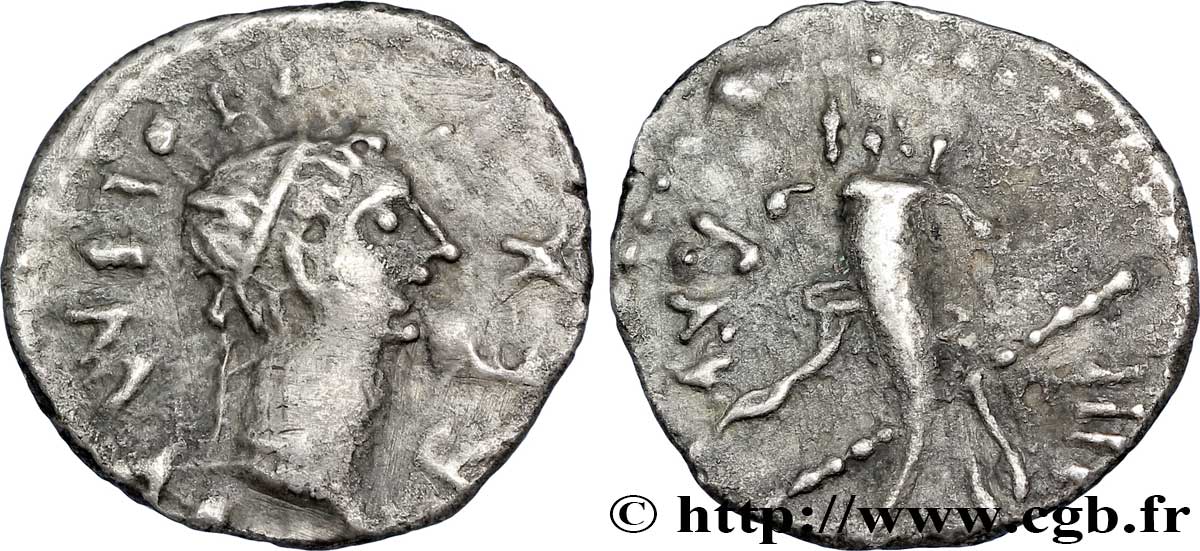v59_0239 - REGNO DI MAURETANIA - PTOLEMEO Denier
MONNAIES 59 (2013)
Prezzo di inizio : 450.00 €
Valutazione : 750.00 €
Prezzo realizzato : 530.00 €
Numero di offerte : 3
Offerta maxima : 1 365.00 €
Prezzo di inizio : 450.00 €
Valutazione : 750.00 €
Prezzo realizzato : 530.00 €
Numero di offerte : 3
Offerta maxima : 1 365.00 €
Tipo : Denier
Data: an 4
Nome della officina / città: Césarée, Maurétanie
Metallo : argento
Diametro : 15 mm
Asse di coniazione : 12 h.
Peso : 1,81 g.
Grado di rarità : R3
Commenti sullo stato di conservazione:
Exemplaire sur un petit flan ovale et irrégulier bien centré des deux côtés mais court au revers sur la date. Très beau portrait de Ptolémée, bien venu à la frappe. Revers de style fin avec le grènetis visible. Jolie patine de collection ancienne avec des reflets dorés. Conserve une partie de son brillant de frappe et de son coupant d’origine
N° nelle opere di riferimento :
Pedigree :
Cet exemplaire provient du stock Bourgey en 1990 et de la collection du docteur Thierry de Craeker
Diritto
Titolatura diritto : REX - PTOLEMAEVS.
Descrittivo diritto : Buste diadémé et drapé de Ptolémée à droite, (A’01).
Traduzione diritto : “Rex Ptolemaeus”, (roi Ptolémée).
Rovescio
Titolatura rovescio : R A - IIII.
Descrittivo rovescio : Corne d’abondance posée à gauche avec un sceptre transversal à droite.
Traduzione rovescio : (règne an 4).
Commento
Poids léger. Normalement, Ptolémée a succédé à son père Juba Ier en 23. Mais en fait, il est associé aux affaires depuis 20 après J.-C. La datation des années régnales devrait donc se faire à partir de cette date. Ce type semble beaucoup plus rare que ne le laissent supposer les ouvrages généraux. Sur cet exemplaire l’année régnale est difficile à interpréter. C’est normalement an 4, mais après le A, on pourrait deviner un X alors nous aurions l’an XIIII. C’est la première fois que nous le proposons à la vente.
Lightweight. Normally, Ptolemy succeeded his father Juba I in 23. But in fact, he has been involved in affairs since 20 AD. The dating of the regnal years should therefore be done from this date. This type seems much rarer than general works suggest. On this example, the regnal year is difficult to interpret. It is normally year 4, but after the A, we could guess an X, so we would have year XIIII. This is the first time we are offering it for sale
Lightweight. Normally, Ptolemy succeeded his father Juba I in 23. But in fact, he has been involved in affairs since 20 AD. The dating of the regnal years should therefore be done from this date. This type seems much rarer than general works suggest. On this example, the regnal year is difficult to interpret. It is normally year 4, but after the A, we could guess an X, so we would have year XIIII. This is the first time we are offering it for sale








 Segnalare un errore
Segnalare un errore Stampate la pagina
Stampate la pagina Condividi mia selezione
Condividi mia selezione Fai una domanda
Fai una domanda Consegnare / vendere
Consegnare / vendere










